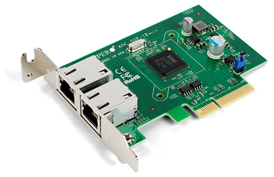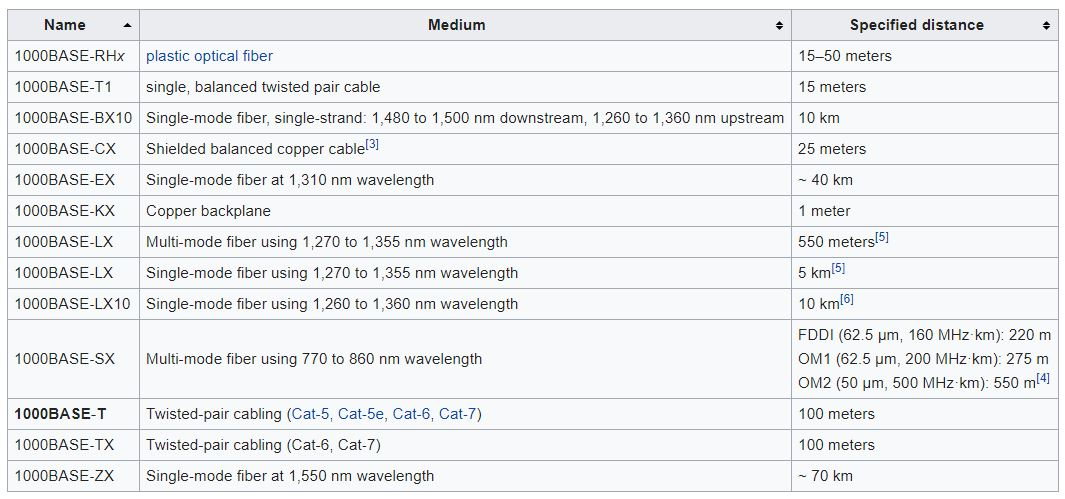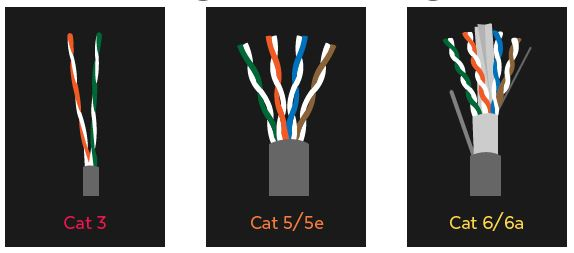Gigabit Ethernet an Informative Guide
IP vs. Gigabit - Related Articles

1. Summary:
Gigabit Ethernet is part of the Ethernet family of computer networking and communication standards. The Gigabit Ethernet standard supports a theoretical maximum data rate of 1 Gigabit per second (Gbps) (1000 Mbps).
What is Ethernet?
A system for connecting a number of computer systems to form a local area network, with protocols to control the passing of information and to avoid simultaneous transmission by two or more systems.
Gigabit Ethernet is abbreviated as GbE or 1 GigE.
It works well using twisted pair copper cable (specifically, the CAT5e and CAT6 cabling standards) similar to older 100 Mbps Fast Ethernet (that works over CAT5 cables).
Gigabit Ethernet uses the same 802.3 frame format, and access protocol (Carrier Sense, Multiple Access with Collision Detection, CSMA/CD) to remain backwards compatible with standard 10 Mbps and 100 Mbps Ethernet. The packet format is variable length (64-1514 byte) packets, unlike ATM, which uses a fixed length cell.

Fig: Supermicro AOC-SGP-I2 dual-port Gigabit Ethernet NIC, a PCI Express ×4 card
Image Source: Wikipedia
2. Advantages
- Support for the same frame format as 10/100 Mbps standards
- Transmission rate is 100 times greater (1Gbps)
- Full-duplex with switching devices (802.x standard)
- Backward Compatible with existing installed Ethernet
- Highly modular hardware approach.
- Reduces bottleneck problems and enhances bandwidth capacity, resulting in superior performance
- Offers full-duplex capacity that can provide virtually doubled bandwidth.
- Offers cumulative bandwidth for faster speed by employing gigabit server adapters and switches.
- Quality of service (QoS) features reduced latency problems and offers better video and audio services
- Highly affordable to own
3. Disadvantages
- Limited availability of Products
- Gateway device necessary to interface to wide area link protocol
- Ethernet does not support time-sensitive data
4. Types of Gigabit Ethernet

Image Source: https://en.wikipedia.org/wiki/Gigabit_Ethernet
5. Does Gigabit need special cable / hardware?
What happens if your device only supports, say, 100 Mbps Ethernet but you plug it into a gigabit-capable port? Does it instantly upgrade the device to use gigabit internet?
No, it doesn't. All newer broadband routers support Gigabit Ethernet along with other mainstream computer network equipment, but Gigabit Ethernet also provides backward compatibility to older 100 Mbps and 10 Mbps legacy Ethernet devices.
Connections to these devices function normally but perform at the lower rated speed. In other words, you can connect a slow device to a fast network and it will only perform as fast as the slowest rated speed.
The same is true if you connect a gigabit-capable device to a slow network; it will only operate as fast as the slower network.
The 802.3z working group has drawn heavily on the Fiber Channel specification FC-0 and FC-1 for the physical layer. This permits the same integrated circuits to be utilized for lower cost and quicker time to market.

Typical Ethernet networks have throughput of approximately 70% of the wire speed. Early simulations of Gigabit Ethernet show improvement over 100 Mbps Ethernet by an order of magnitude.
|
|
Max. Length of cable * (meters) |
Speed Compatibility |
Bandwidth (Mhz) |
|
CAT-5 |
10 (Unshielded) |
10-100Mbps |
100 |
|
CAT-5e (e-enhanced) |
100 (Unshielded) |
10Mbps to 1Gbps |
100 |
|
CAT-6 |
100 (Un/Shielded) |
10Mbps to 10Gbps |
250 |
|
CAT-6a (a-augumented) |
100 (Shielded) |
10Mbps to 10Gbps |
500 |
|
CAT-7 |
100 (Shielded) |
10Mbps to 10Gbps (100Gbps at 15m) |
600 |
*Max length may reduce at higher data speeds.
6. Legacy Issue
Gigabit Ethernet could give a performance boost (10 to 100 times) in the already existing copper cabling (cat5/5e) without forced transition to optical fiber cable.
Cat 5 installations should be tested for parameters such as power sum, return loss and cross talk before up gradation for full duplex 4 pair cables that is used in the operation of Gigabit Ethernet.
Cat-5e installations provide better electrical performance than Cat- 5 - The signal margin provided by the cat 5e may ensure a more effective Gigabit Ethernet deployment.
Environmental factors that affect the cabling system like temperature, humidity, installation methodology have an impact on speed and reliability of the communication at gigabit speeds.
According to the standards (EIA/TIA 568) it is specified the temperature should not be exceeded more than 60°C, but due to the environmental conditions this threshold may be exceeded. Therefore Cat-6 compliance improves the cable's ability to handle the data at higher temperatures.
End-to-end Gigabit delivers: Tests found that GbE produced a 47% improvement over 100/10 network response time when accessing Microsoft SQL database records and a 40% response time improvement in executing common MS Office tasks (Source CSA Research/InfoWorld).
Here is a link to guide in upgrading to Gigabit Ethernet: https://www.wikihow.com/Upgrade-Your-Network-to-Gigabit-Ethernet
Further reading on Gigabit Ethernet:
https://www.cisco.com/en/US/tech/tk389/tk214/tech_brief09186a0080091a8a.html


